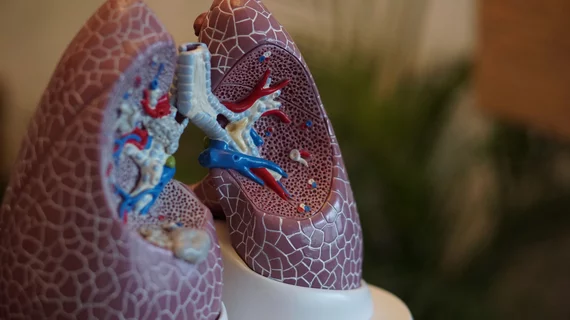Radiologists use algorithm to diagnose tricky lung disease typically reserved for thoracic specialists
With the help of a new CT algorithm, non-expert radiologists can diagnose one of the most difficult to assess lung diseases in thoracic imaging at levels similar to trained cardiothoracic doctors.
Diffuse parenchymal lung disease (DPLD) is an umbrella term covering many different pulmonary disorders. But varied and overlapping imaging appearances make it hard for even top radiologists to pin down.
With this in mind, a veteran doctor created a training module that outlines a step-by-step process for building a differential diagnosis based on distinct DPLD imaging patterns. The tool helped non-expert rads list a correct diagnosis in their top three choices 65% of the time, compared to nearly 50% before training.
Although the non-experts did not perform as well as specialists overall, the module is certain to help guide decision making, Ali H. Dhanaliwala, MD, PhD, of the University of Pennsylvania Health System’s Department of Radiology, and colleagues reported Sunday.
“For many diagnostic questions … it is important to ensure the correct diagnosis is at least being considered as this can guide additional testing,” the authors added in Academic Radiology. “By improving the radiologist's ability to include the correct diagnosis among the differential, our structured approach can ultimately help the clinician even if the correct diagnosis is not the top diagnosis.”
For the study, five cardiothoracic-trained docs and 25 non-experts were each asked to create a top three differential from a semi-random subset of cases taken from a large DPLD high-resolution CT database. The non-specialists then turned to the training flowsheets with 75 imaging examples for assessing parenchymal lung diseases. Following a learning period, they were again asked to create a differential diagnosis of up to three solutions from a pre-defined list of 26 outcomes.
Looking over 1,400 studies, non-experts identified the correct diagnosis in 41.2% of cases and included it within their top three 65% of the time. Prior to training, they did the same in 32.5% and 49.7% of exams, respectively.
By comparison, cardiothoracic radiologists correctly diagnosed the disease in 48% of situations while identifying it within their top three in 64.3% of exams.
“Despite gains made by use of the training algorithm, non-experts were unable to match the performance of expert chest radiologists in identifying the correct diagnosis from radiologic findings alone,” the authors concluded. “Our findings demonstrate that while non-experts may not be able to identify the correct diagnosis, with training they are able to include the correct diagnosis within the differential.”
Read the full study here.

